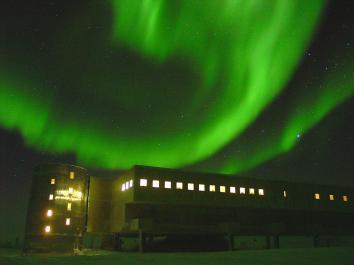The National Science Foundation staffs three main research centers in Antarctica—the McMurdo, Amundsen-Scott, and Palmer stations—and all of them are about to become ghost towns, thanks to the government shutdown. Unfortunately, this doesn’t just mean a few college kids will miss out on field trips. Forced evacuation from Antarctica means a colossal disruption to new and ongoing science, including that which helps us understand climate change. (It also means the media can use all those Mr. Freeze puns they’ve been saving up.)
Now, I’ve never been to Antarctica, so when I heard about the withdrawal, I imagined a few snow-blown shacks dimming the lights and battening down the hatches. In fact, these stations are more akin to full-blown frontier towns and they provide support for hundreds of people. (You can get a bird’s eye view of the McMurdo Station on the United States Antarctic Program’s website, presuming they don’t turn off the webcam over the next few days.)
Unfortunately, the government shutdown hits just as Antarctica is coming into spring, which means the start of a new research season. These towns had already begun to prepare for the scientists’ arrival. The NSF spends just under $400 million a year to keep the stations open for the some 1,200 researchers who travel for weeks to conduct experiments on the bottom of the world. One ship was scheduled to dock on Wednesday of this week. So imagine that conversation: “Yeah, sorry, I know you guys just spent a few weeks in cramped quarters in order to live in total seclusion and track the same penguins you’ve been studying since 1990, but uh …”
According to the USAP closure announcement—which you’d think would have more curse words—bare-bones crews will be left behind to “ensure human safety and preserve government property, including the three primary research stations, ships, and associated research facilities.”
The cost to science is staggering. According to Katie Valentine of ThinkProgress, “Hundreds of scientists’ studies in glaciology, ecology, and climate-related fields [will] grind to a halt.” Ice core sampling, glacier mapping, and water acidity testing will all cease. Most of all, people need to understand that scientific testing isn’t something you can just turn off and on at will. The USAP addresses this in its announcement:
“It is important to note, however, that some activities cannot be restarted once seasonally dependent windows for research and operations have passed, the seasonal workforce is released, science activities are curtailed and operations are reduced.”
In other words, a government shutdown at this precise moment means some scientists will lose an entire year of research opportunities. All because a few elected officials don’t agree with a health care law. (Not that we dare dream Tea Partiers are crying themselves to sleep over the side effect of disrupted climate research.)
Of course, Antarctica isn’t the only community affected by the shutdown. Families of soldiers killed in action are being denied death benefits. Federal employees in the Grand Canyon National Park have turned to the generosity of a local food bank to help them get through to their next paycheck, whenever that may be. (Unfortunately, the food bank is running out of supplies.) And you probably haven’t even thought about the thousands of lab animals that will be euthanized as a result the government shutdown.
Somewhere on the open ocean, there’s a ship full of penguin scientists on a slow crawl to the United States. Will the government shutdown have ended by the time they get back? If I were them, I’d be pretty miffed either way.
